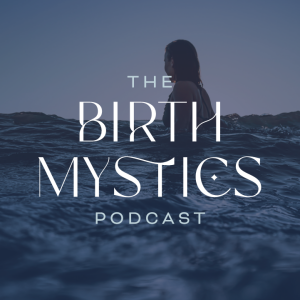Birth Mystics
Welcome to the Birth Mystics podcast. Who, or what, is a birth mystic? Doulas Katie and Stephanie define it as someone who seeks to embrace the magic, mystery and metaphor of birth. Think ”birth nerds” but with a bit more depth. Here we explore birth through the lens of mythology, poetry, spirituality, psychology, and more.
Episodes

Monday Jun 02, 2025
Monday Jun 02, 2025
We look with new eyes at the ancient myth of Ariadne, Theseus and the minotaur. You may think you know this myth, but in today's episode Stephanie teases out some of its deeper and less-explored meanings. Ariadne's thread can be a beautiful metaphor of mind-body connection, and as we learn to follow the thread we become more fully yoked and experience greater balance and well-being. This episode looks at building our emotional readiness and resilience to prepare ourselves for better emotional outcomes in the birth space. Stephanie takes her listeners through a guided meditation, for which we recommend you tune in when you are in a safe and comfortable place in order to be able to follow your own internal thread.
To learn more about Stephanie's work, check out her website (bhavabirth.com) and connect with her on IG (@bhava_birth).

Monday May 19, 2025
Monday May 19, 2025
Manifesting has become part of our everyday language and culture, but how does it really work? Does it actually work? What place does it have in the birth space? As doulas, Katie and Stephanie have seen manifesting used in both beautiful and counterproductive ways. When manifesting is used as another way to "control outcomes" it can become just one more road to dashed expectations and disappointment. But when manifesting is approached through neuroscience and somatics, where the body and mind are allowed to work together, there is great potential for big impact. Join us in this engaging discussion that could very well change the name of the game for your birth and life!
To learn more about Katie's work, visit her website (freyabirth.com) or connect with her on IG (@freyabirth). Book referenced: Mind Magic, by James R. Doty MD

Monday May 05, 2025
Monday May 05, 2025
A closer look at the Genesis creation story helps us understand the spoken and unspoken precedents that underlay it. The way it has been interpreted and taught, over the centuries, inevitably leads us into the realm of Mind OVER Matter, where creation does not involve the flesh and blood but is solely a product of thought. In this sense, we are a technology of the gods; how does this show up in our modern birth culture? What does it look like when birth is no longer a process of flesh and blood, the human body erased, the feminine aspect forgotten, and overly controlled and dictated by technology? But things can go too far the other direction, unfortunately, in a Matter OVER Mind culture, where technology is needlessly vilified. This episode is an exploration into the world of Mind AND Matter where these two energies, or parts of the human experience, are balanced.
To learn more about Stephanie's work, visit her website (bhavabirth.com) or connect on IG (@bhava_birth). Book referenced: The Flesh & the Fruit: Remembering Eve & the Creative Power of Transgression, by Dr. Vanya Leilani

Monday Apr 14, 2025
Monday Apr 14, 2025
Katie shares her very personal and stirring poem about the "uninhabitable house" that was her body. Together with Stephanie, they discuss the journey we undertake to inhabit ourselves, to live fully embodied, and how that directly affects our birthing experiences. They look at how our modern worship of clocks and mirrors, or in other words time and appearances, keep us living outside of our own homes and how this hugely affects our birthing experiences.
To learn more about Katie's work, visit her website: freyabirth.com. You can also connect with her on Instagram: @freyabirth.

Monday Mar 31, 2025
Monday Mar 31, 2025
The Day Boy and the Night Girl is a powerful myth written by Scottish author George MacDonald and was published in 1880. Today, Stephanie peels back some of its many layers to reveal impactful insights around the integration of masculine and feminine, light and dark. So much of fear, in birth and life, stems from lack of familiarity and facing the unknown. How can we spend more time acquainting ourselves with the parts of ourselves that are lesser known so that we can build that familiarity? This draws interesting parallels to brainwave patterns and spending intentional time preparing for birth in Alpha and Theta states of being. Dive deep into the world of Photogen and Nycteris, the Day Boy and the Night Girl, as they teach us more about our own inner worlds.
To learn more about Stephanie's work, please visit her website: bhavabirth.com. You can also connect with her on Instagram @bhava_birth.

Monday Mar 17, 2025
Monday Mar 17, 2025
In today's episode, Katie shares the Greek myth of Medusa, pulling in some key and lesser known backstory, shedding light on what up to her becoming the snake-haired terror that turns men to stone. She draws upon the imagery of Perseus' shield, what he used to defeat Medusa, to guide all of us as we heal from trauma. Drawing from Peter Levine's teachings, Katie brings this compassionate and important discussion into the world of birth and personal empowerment.
To learn more about Katie's work, visit her website: freyabirth.com. You can also connect with her through IG: @freyabirth.
Source cited: Healing Trauma, by Peter Lavine

Monday Mar 03, 2025
Monday Mar 03, 2025
Stephanie shares one of the greatest birth hacks of all time--understanding brainwaves and consciousness. Brainwaves are a Western empirical understanding of how thoughts emit certain frequencies, whereas consciousness is an Eastern spiritual understanding of how we experience oneness. When these traditions overlap, we discover astounding relevance for our birth experiences and our lives. By understanding where your brain is trying to take you during labor, you can help it along by adapting your environment, trusting the process, and surrendering to the descent. When we don't understand this process, we often fight against it unknowingly, especially if we love being in control, leading to more adverse outcomes.To follow Stephanie's work, you can visit her website, bhavabirth.com, or follow her on IG: @bhava_birth.

Monday Feb 17, 2025
Monday Feb 17, 2025
Katie masterfully brings together the Celtic mythology of Selkies and the journey of birth. Selkies are mythological creatures that shape shift from seal to human by removing or putting on their seal skin. What lessons do Selkies teach us? What symbolism can we draw upon to support spiritual and emotional transformation? Listen in as Katie and Stephanie plunge into the deep end with today's magical episode.
To follow Katie's work, you can visit her website, freyabirth.com, or follow her on IG: @freyabirth.

Monday Feb 03, 2025
Monday Feb 03, 2025
Stephanie leads a discussion on the powerful short story The Yellow Paper, a semi-autobiographical novella written at the turn of the century by Charlotte Perkins Gillman. This is a compelling, haunting story of a woman's rebirth that is tragically thwarted; she is prescribed the rest cure during her postpartum, separated from her baby and loved ones, and confined to an old nursery in a cottage house in the remote countryside. Stephanie walks you through the symptoms of her thwarted awakening as a tale of woe, giving us a crystal clear template of what not to do. This story couldn't be more pertinent today as our society faces an alarming rise of PMADs. We've been conditioned to fear postpartum and deeply misunderstand its healing potential. In this episode, postpartum is reclaimed and redefined, giving us a new paradigm to identify and support the too often overlooked symptoms of our own awakening.
To follow Stephanie's work, you can visit her website, bhavabirth.com, or follow her on IG: @bhava_birth.

Monday Jan 20, 2025
Monday Jan 20, 2025
Katie shares about the birth of her fourth child and the intentionality that went into. Along with Stephanie, they discuss how to bring more mindfulness into motherhood, beginning with the act of conception itself.
To learn more about Katie's work, visit freyabirth.com.

Meet Your Host, Katie
freyabirth.com

Meet Your Host, Stephanie
A mystic to the core, Stephanie invites you to dive into the depths and be transformed by birth.
Stephanie is a mentor, writer, and space holder for the Birth and Rebirth journey. Her work as an educator, Yoga Therapist, and Doula are the very heart of her life's work. She offers an online mind-body-focused childbirth education course, birth and postpartum doula trainings, and therapeutic private sessions. Her one-on-one work includes somatic release, birth story processing, and personal mentoring. With the help and support of her husband, together they are raising four children in beautiful Provo, Utah.
bhavabirth.com







